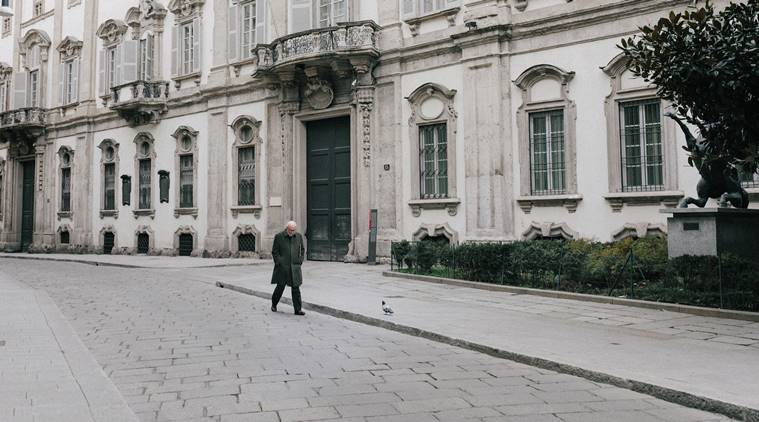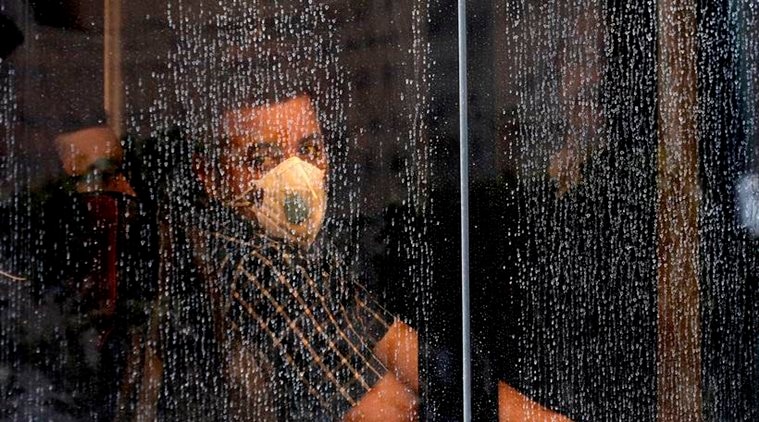 FILE — A pedestrian in an almost empty street in Milan’s city center (Andrea Mantovani/The New York Times)
FILE — A pedestrian in an almost empty street in Milan’s city center (Andrea Mantovani/The New York Times)
Written by Jason Horowitz ( Emma Bubola contributed reporting in Milan and Elisabetta Povoledo contributed reporting in Rome.)
Italy’s government weighed Saturday the extraordinary step of locking down much of the country’s north, restricting movement for about a quarter of the population in regions that serve as the country’s economic engine.
If implemented, it would be the most sweeping effort outside China to stop the spread of the coronavirus and would be tantamount to sacrificing the Italian economy in the short term to save it from the ravages of the virus in the long term.
Italy’s outbreak, already the worst in Europe, has inflicted serious damage on one of the Continent’s most fragile economies. It has led to the closure of schools and by Saturday, it had infected the leader of one of the two parties in the governing coalition.
The measures, if approved, would turn stretches of Italy’s wealthy north — including the economic and cultural capital of Milan and landmark tourist destinations such as Venice — into the quarantined red zones until at least April 3. It could prevent the free movement of roughly 16 million people.
By Saturday, Italy had more than 5,800 cases of the virus, 233 of them fatal, with increases of almost 800 infections and 49 deaths from the day before. Only China has had more people die after contracting the virus.
As the government met late into the night Saturday, ministers insisted the proposals were merely a draft. Confusion spread about whether officials would actually block travel or only recommend against it.
As soon as the draft became public, shocked regional and municipal leaders in the north argued that they were caught off-guard and that implementing the rules so suddenly would be impossible.
Italian media reported that an additional draft under consideration by the government would also extend the less restrictive measures previously imposed in the north, such as the closure of museums, to the rest of the country.
Critics of the government argued that the late-night meeting reflected a lack of coordination and communication with the country that had caused confusion amid the crisis.
According to the draft, published by several Italian news outlets and confirmed by government officials, authorities would need to approve special travel permissions in or out of the designated areas for family or work emergencies.
This would all be part of “urgent measures to contain the contagion” in the Lombardy region and 13 other districts in the Veneto, Piemonte and Emilia Romagna regions in the country’s north.
Weddings, funerals and cultural events would all be banned under the measures. Failing to keep the required distance of one meter, including in sporting events, bars and supermarkets, could lead to the shuttering of businesses and criminal charges.
Police officers and soldiers would be empowered to enforce containment measures. Churches could remain open, but masses would be off limits and the faithful would have to stay at least one meter apart from one another.
A Lombardy official confirmed that the measures being discussed would essentially close down the northern region, Italy’s largest and most productive, which accounts for a fifth of Italy’s GDP.
Matteo Caroli, a professor of business management at Luiss Guido Carli University in Rome, said that if “the measures go beyond April, the situation will become systemic and the damage serious.”
Last week the government announced a huge support package of 7.5 billion euros ($8.5 billion) in addition to 900 million euros announced last week for families and business damaged by the virus.
Leaked reports of the draft late Saturday night prompted panic in Milan but also resistance and anger from mayors and regional presidents across the political spectrum in the northern areas.
Attilio Fontana, the president of the Lombardy region, and a prominent figure in the right wing League party, said the plan moved in the direction of containing the virus with decisive measures but also called the plan a “mess,” according to Italian news agency ANSA, because it created confusion about what citizens could and could not do.
Luca Zaia, the president of the Veneto region that includes Venice and other cities marked for lockdown, said that the government had only notified him about the potential ban “at the last minute” and they had serious concerns. Since the region was kept out of discussions to draft the order, he said, “it’s literally impossible” for the region to enact it so quickly.
 A commuter looks through a water-stained window wearing a mask and gloves to help guard against the Coronavirus (AP)
A commuter looks through a water-stained window wearing a mask and gloves to help guard against the Coronavirus (AP)
The government order would also lock down provinces in the Emilia Romaga region south of Lombardy. Stefano Bonaccini, the region’s liberal president, implored the Italian prime minister, Giuseppe Conte, and the country’s health minister, both nominal allies, for more time to come up with a more “coherent and shared” solution.
Mayors in some of the cities marked for quarantine expressed deep ire over first hearing about the proposed order on television.
”It’s incredible,” said Rasero Maurizio, the mayor of Asti in the northern region of Piedmont, who posted a livid video of himself in a white T-shirt from his home saying that he had just heard about the potential closing of his town on television. “No one told me.”
In addition to Asti, Modena, Parma, Piacenza, Reggio Emilia, Rimini, Pesaro and Urbino, Venice, Padua, Treviso, Asti and Alessandria — all in the north — were set to be locked down.
But there were clear signs that the virus was spreading southward. Earlier Saturday, it touched the top of Italian politics as the leader of the governing coalition’s Democratic Party said he was infected.
“Well, it’s arrived,” Nicola Zingaretti, the leader of the Democratic Party and the president of the region of Lazio, said in a Facebook video posted Saturday. “I also have the coronavirus.”
The infection of Zingaretti, who is based in Rome, provided vivid proof that the virus was no longer a matter of northern exposure, and that the entire country was now grappling with a public health emergency.
Zingaretti, the head of the country’s largest center-left party and one of the two parties leading Italy, has daily contact with top politicians in the capital as well as his party’s rank and file members.
Already some members of Italy’s Parliament who come from the locked down areas in the Lombardy region have been quarantined. But the infection of a highly prominent figure like Zingaretti, who felt feverish Saturday, raised the prospect that more Italian politicians had been exposed.